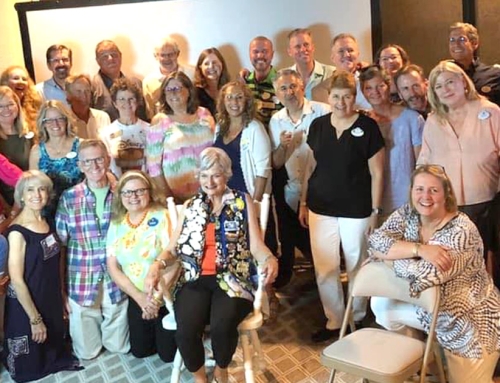When Culture and Strategy Collide
This article, by Jake Poore, is currently featured in the July/August 2015 issue of HeathCare Executive Magazine, a publication of the American College of HealthCare Executives.
Many say the definition of insanity is doing the same thing over and over again and expecting different results. But a savvy lawyer might say, “If you’re not willing to think and act differently, then we should choose the insanity defense.”
In healthcare, isn’t that exactly what we’re doing? We purchase off-the-shelf programs, conduct events and initiatives and so on in the fervent hope that something will improve low patient satisfaction scores.
To measure success, we rely on multiple satisfaction surveys to learn whether we are meeting or exceeding patient expectations and where we are falling short.
Often, the results mimic a roller-coaster ride of month-to-month highs and lows, with no good answer to the question: “Specifically, what are we doing differently?”
With such inconsistencies, we are left with little choice but to revise our strategic plan by adding another new mandatory protocol, another new initiative. Many seasoned employees then say, “Lay down long enough and this too, will pass.”
And unfortunately, they are right.
As baseball legend Yogi Berra says, “We’re lost … but we’re making great time!”
It’s a common situation. A simple Internet search reveals hundreds of articles with “solutions” on how to improve patient experiences. If you are looking to temporarily boost your scores,these solutions may provide a short-term fix; however, they are not sustainable. You can no longer just “teach to the test” and “strive for fives.” You cannot change the patient experience overnight. The strategies and tactics you need to implement have a vital prerequisite: You must first change your culture.
Changing your culture – or, at the very least, clearly defining it and aligning it with your strategic plan – takes time and tremendous effort, but the payoffs are worth it, both financially and intrinsically.
“Where I see organizations fail is when they focus only on clinical expertise with nothing specific to the patient,” says Joseph Jasser, MD, president/CEO, Dignity Health Medical Foundation. “In the age of consumerism, the organizations that do the best are the ones that put the patient experience above everything else.”
Changing the Organizational Dynamic
Successfully uniting culture and strategy involves thinking differently. We can no longer be just prescriptive. We cannot launch a one size fits all laundry list of things employees should do or say to improve the patient experience.
Change happens when a patient-driven culture is woven ~ or hardwired ~ into the DNA of an organization.
There are two keys to success in hardwiring a patient-driven culture.
1. Involve every type of stakeholder in the process of building or redesigning the culture. Gather employee representatives from all major areas of the patient experience to be the architects of your cultural blueprints. Architects should be both clinical and nonclinical, executive and frontline, and patients. In the end, we must be able to say, “This was developed by us and our patients, for us and our patients.”
2. Develop a common set of tools, common language and clear end goals. Everyone must be able to clearly define what it is they stand for and the types of behavior they will no longer tolerate. Clarity creates alignment; a common language and tools create empowerment; and a consistent decision-making process creates consistency and mutual accountability throughout each step of the patient experience.
Mary N. Mannix, FACHE, CEO, Augusta Health in Fishersville, Va., is leading her team on just such a mission.
“We knew that if the patient experience was the needle we really wanted to move, we had to come at it from a cultural alignment perspective versus just a set of tactics and numbers and reward,” Mannix says. “Our biggest critical success factor is that this isn’t just a top-down process; it cuts across all employee lines, from the care team to the call center to the environmental services team. It’s not just leaders who have a voice; it’s our frontline staff as well, because that’s where our mission is fulfilled every day.”
Creating a Culture of Always
The key to creating a culture of “always” versus a culture of “sometimes” is to engage the entire organization in the process of building something so specific and explicit, team members know it when they see it and they know when they do not. Eliminating cultural departmental silos is not enough. The culture has to work horizontally, across all departments, mirroring your patients’ experiences with your organization.
Engaging everyone as an architect of the organizational culture is the difference between short-term compliance and long-term commitment. “If you build it, they will come” is a great movie line, but a more accurate mantra for a successful cultural transformation is: If they build it, they will own it.
Ownership in the culture they create leads to strong feelings of pride, which lead to your staff protecting and policing the culture. That is when a grassroots culture catches fire.
At Augusta Health, employees, patients and families were all engaged in the process of creating what is now known as The Augusta Way. “One of the biggest and earliest surprises during this cultural transformation was the high levels of employee engagement,” Mannix says. “The Augusta Way isn’t about chasing a number or improving patient satisfaction scores, although that is clearly a desired outcome. Our entire organization came together to decide how we will treat our patients and their families and how we will treat each other.”
Building a patient-driven, employee-owned culture is not enough, though. It has to be sustained. This requires engaged employees who are committed to delivering that “always” experience they helped define.
Dr. Jasser says he has realized an unexpected benefit of the successful cultural transformation taking place in his organization. “The halo effect that this has created is astronomical. It’s elevated our employee and physician engagement scores beyond anything I ever dreamed of. And with everyone aligned toward one vision, one goal, it translates into employee engagement, job commitment and loyalty to the company.”
For current employees, a process must be in place to ensure that the message “This is how we do things here” is communicated horizontally to every corner of the organization and localized downward to every level of the care team.
“Our approach is focused on one measurement and one goal for everybody – a positive response to the question “Would you recommend us?” – which is aligned with the Net Promoter Score surveys.” Jasser says.
Creating a culture of “always” has improved patient satisfaction scores at both Mercy Medical Group (MMG), a service of Dignity Health Medical Foundation, and Augusta Health.
In the first quarter of 2015, scores for “Staff at MMG are always helpful” rose 3.04%, while scores for the question “I would recommend MMG without hesitation to others” rose 1.89%. At Augusta Health, patients who rated a health system a ‘9’ or ’10’ increased from 70 percent in 2013 to 75 percent in 2014, while the number of patients who indicated they would “definitely recommend” the health system increased from 70 percent in 2013 to 74 percent in 2014.
We have all heard the phrase “Culture eats strategy for lunch.” The reality is, you need both culture and strategy to be successful. When you start with a patient-driven, employee-built, clearly defined culture, every team member shares the same vision for how care is delivered.
That is when patient experience becomes more than what you do as an organization – it becomes who you are.
***************************************
This is what our team does best. We don’t just offer prescriptive solutions ~ we work with care teams to develop a clearly-defined culture as well as a common set of tools. Then, we teach them how to hardwire it so it becomes common practice. Want to learn more? Visit www.wecreateloyalty.com. Or call us at (407) 859-2826; email us at info@wecreateloyalty.com or tweet me at @jakepoore.






Leave A Comment